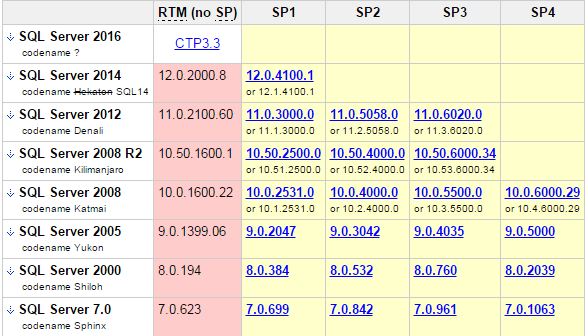Sql Server Version List
In the tables below, services that can have multiple instances on the same server have the default instance name listed first and then a named instance – “Contoso1.” These services names are without any service packs being applied. I haven’t checked to see if there are any changes to service names after installing service packs.
Attention: The internal data of table “6” is corrupted!Please refer to the following Legends and acronyms used in the list: CTPCommunity Technology Preview (beta release)RCRelease CandidateRTMReleased To Manufacturing: It is the original, released build version of the product, i.e. What you get on the DVD or when you download the ISO file from MSDN.CUCumulative Update: Cumulative updates contain bug fixes and feature enhancements–up to that point in time–that have been added since the previous Service Pack release and will be contained in the next service pack release.

Installation of the Cumulative Update is similar to the installation of a Service Pack. Each CU will contain all the updates of the previous CU for a given SQL Server version.SPService Pack: Merging all the CU’s and additional features makes a large collection of hotfixes that have been fully regression tested. In some cases it delivers product enhancements.GDRGeneral Distribution Release: GDR fixes should not contain any of the CU updates.QFEQuick Fix Engineering: QFE updates include CU fixes.If there are any build numbers that you are unable to find, please let us know in the comments section and we will add it to the list.

Note: In Accounting CS and Workpapers CS, only the build number is given for the SQL version. The table below lists some SQL build numbers and their corresponding versions.
Sql Server Management Studio Version List
Build numberSQL version10.xxSQL 2008/2008R211.xxSQL 201212.xxSQL 201413.xxSQL 201614.xxSQL 2017SQL 2008 and 2008 R2 will not be supported as of July 9th, 2019. See for more information.Using the SQL Server Installation CenterUse the following steps to see all installed instances of SQL and the information about that instance. At the SQL Server, use the Start menu to search for and launch the SQL Server Installation Center. On the left side of the SQL Server Installation Center, choose Tools. On the right side, choose Installed SQL Server features discovery report. The report will open in your default web browser.
Sql Server Build Number List
This icon appears alongside links to resources that are not developed or maintained by Thomson Reuters. We provide access to these resources for your convenience, but we are not responsible for their accuracy. If you need additional assistance, please consult your qualified technician and/or the vendor who developed the resource.Note: If FileCabinet CS is reporting that you are using SQL Express, but you believe that the instance is using a full version of SQL, you can open the instance in SQL Management Studio, and enter the following query to determine what edition is being reported by SQL: sqlcmd -Sservername -q'select SERVERPROPERTY('edition')'.Share This.